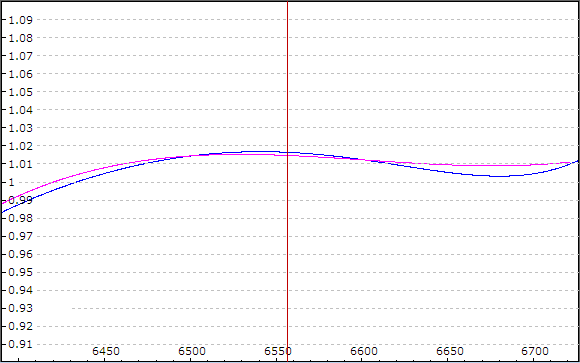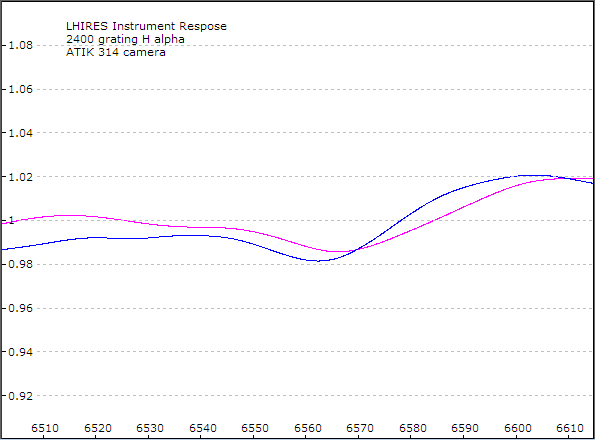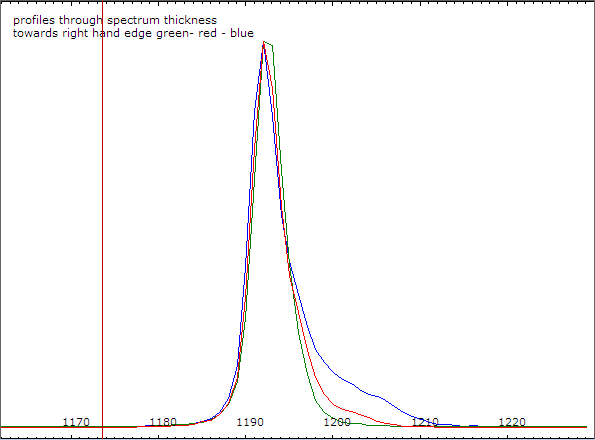› Forums › Spectroscopy › Instrument response with Lhires
- This topic has 18 replies, 4 voices, and was last updated 5 years, 5 months ago by
 Robin Leadbeater.
Robin Leadbeater.
-
AuthorPosts
-
11 August 2018 at 4:11 pm #574105
 Kevin GurneyParticipant
Kevin GurneyParticipantI thought I would ask this in a separate thread as its a matter of principle and nothing to do with tweaking the kit.
So, with the Alpy, we are enjoined to take the spectrum of a nearby reference star (typically in MILES database) and use this to obtain an instrument response (IR). I can see this works for low resolution, because it makes sense to talk about the continuum response (smooth curve, ignoring line features). However, with high resolution, its quite often the case that the bulk of the spectrum is a line feature (I am thinking of Vega’s Ha line, for example).
So, how do we define the continuum respone in this case? And should we be trying to replicate the IR calibration step using a companion reference spectrum, as per low res (Alpy etc)? Could you get away with some stock spectra you have taken at different air-masses? Or just rectify the spectrum and obviate the problem at source, as it were?
Cheers
Kevin
11 August 2018 at 6:49 pm #579865 Robin LeadbeaterParticipant
Robin LeadbeaterParticipantHi Kevin,
You can do an instrument response in the usual way but you need a high resolution spectrum to compare with so you can match profile including the line. You can see an example of that about halfway down on Christian Buil’s page on reducing LHIRES spectra here
http://www.astrosurf.com/buil/isis/guide_lhires/tuto1_en.htm
and also specifically covered on this page
http://www.astrosurf.com/aras/tutorial5/note1_us.htm
Fortunately unless you are working at the far blue end, atmospheric extinction does not have much effect over the narrow wavelength range so you can use stars which might be some distance from the target (or even at a pinch instrument responses taken on different nights)
Two good sources for high resolution spectra of bright stars are the UVES bright stars
http://www.eso.org/sci/observing/tools/uvespop/bright_stars_uptonow.html
and provided you are working above 4000A,the ELODIE 3.1 list (spectra from the ELODIE archive selected for quality.) See here on ARAS for more background on this set of stars
http://www.spectro-aras.com/forum/viewtopic.php?f=8&t=1369
Both of these are available in the built in ISIS database (you have to load the ELODIE 3.1 star list)
http://www.spectro-aras.com/forum/viewtopic.php?f=8&t=1864
Is it necessary/worth it rather than just rectifying the spectrum for small wavelength ranges? Possibly not, it depends on the application but BeSS recommends it.
Cheers
Robin
11 August 2018 at 7:00 pm #579866 Robin LeadbeaterParticipant
Robin LeadbeaterParticipantIt is worth noting that the technique of using a reference star near in elevation to the target is technique developed to make it easier for amateurs. Because professionals have stable setups and know their atmospheric conditions, they tend to use a standard instrument response measured infrequently using precisely measured spectrophotometric standard stars, combined with a measure of extinction on the night together with an atmospheric model. ISIS does have the tools to do this though.
http://www.astrosurf.com/buil/isis/guide_response/method.htm
12 August 2018 at 11:04 am #579869 Kevin GurneyParticipant
Kevin GurneyParticipantHi Robin
Once again – thanks for a full and detailed response!
I had tried with a MILES star comparison but, as you say, it should really be done with something at high res. Interstingly though, I did get an ‘instrument response’ which looked typical of that shown on CB’s page.
If I were to take spectra some of the ISIS database reference stars, could I go back and make IR’s to retrospectively apply them?
Cheers
Kevin
12 August 2018 at 12:19 pm #579870 Robin LeadbeaterParticipant
Robin LeadbeaterParticipantYou could try measuring the IR using a high reference resolution spectrum and see how it compares with you MILES IR.(Unless I am working low to the horizon or at the blue end just use a bright star like Vega, Altair, Regulus for example which can be recorded quickly.) If it is significantly different, it might be safer to just rectify the spectra you have already taken. (You can still submit them the BeSS setting the appropriate flag in the fits header.
To be a bit controversial (and this is just my personal view) I think for relative flux calibrated H alpha spectra, most of the time IR correction of a narrow wavelength range at high resolution is a waste of good observing time. (And may even lead to increased variability, though I need to quantify this). If you use a flat, You are already getting rid of all instrument affects as they divide out, leaving the flat lamp spectrum and the atmospheric extinction which hardly varies across the range. If you are using ISIS, this even removes the small slope due to flat lamp spectrum, assuming a black body at 2750K I believe so the IR ends up being effectively a horizontal flat line. In the projects I have been involved in where narrow range spectra have been used, the first step in analysing the data has been to rectify all the spectra first in any case.
Cheers
Robin
12 August 2018 at 1:07 pm #579871 Kevin GurneyParticipant
Kevin GurneyParticipantRobin said: ” I think for relative flux calibrated H alpha spectra, most of the time IR correction of a narrow wavelength range at high resolution is a waste of good observing time.”
Yes – this had been my assumption, albeit based on a hunch rather than any evidential basis…
Uisng ‘precedent and custom’ as the criterion, my encounters with the litertature seem to show rectified data in almost all cases.
Cheers
Kevin
12 August 2018 at 1:49 pm #579872 Robin LeadbeaterParticipant
Robin LeadbeaterParticipantI quickly pulled out a couple of instrument responses at H alpha (using a 1200 l/mm grating so covering a wider wavelength range than the 2400 grating.) They are flat within +-1.5%
 12 August 2018 at 6:02 pm #579874
12 August 2018 at 6:02 pm #579874 Dr Andrew SmithParticipant
Dr Andrew SmithParticipantI agree with Robin’s comment in #5 . You can easily add noise or worse systematic error from the reference.
I simply use the W lamp to remove the blaze from my echelles spectra and then rectify just those orders I wish to measure. The echelles has a more complex set of IR issues than the Lhires III.
Regards Andrew
9 April 2020 at 10:58 am #582247 Kevin GurneyParticipant
Kevin GurneyParticipantGreetings to all in these strange and difficult times… I hope you are keeping safe.
Anyway, I am looking again at the instrument response in my Lhires data. I have a ‘hockey stick’ response with an uptick at the extreme red end (centred on Ha). In the raw spectrum there is a spreading of the line here but, of itself, I dont see that it implies a greater binned amplitude.
As Robin suggested earlier in this thread, I looked at using the UVES stars for reference. I attach a couple of plots showing results for castor and regulus. Each plot shows (i) the non-IR corrected spectrum; (ii) the use of the star’s own IR obtained using the reference in the ISIS database; (iii) the IR from the other star of the pair.
On the one hand, the ‘uptick’ in response at the extreme red end is removed somewhat, in both IR-corrected cases. On the other hand, the corrceted responses differ considerably. Reassuringly, the IR for each star is fairly independent of camera binning (1×1 and 2×2 give good agreemenet for each star) so I think the IRs have been processed OK.
On balance therefore, I am inclined to agree with Andrew, that using IRs in these high-res spectra may introduce other artefacts in an unrelaible way.
Robin, I also note that, in some of your Lhires examples, you crop at around 6612A. I have started to so this too, so the worst of the uptick is discarded.
I would have thought that, as long as it’s clear what you do (I uncheck the IR box on the dbase entry, and insert appropriate comments in the header) its OK to use an uncorrected spectrum?
Keep safe
Kevin
9 April 2020 at 2:22 pm #582248 Andy WilsonKeymaster
Andy WilsonKeymasterHi Kevin,
Good to hear you are finding worthwhile pursuits during the lockdown. Those are interesting results.
If I am reading those plots correctly, you are seeing a 10%-15% difference at the red end of your instrument response when using either Castor or Regulus. That is quite a substantial difference. Assuming the instrument response from the 2 stars were calculated on the same night and under similar observing conditions, were the altitude of the stars similar? If not then the differing effect of atmospheric extinction with altitude might be the cause, though even then I am surprised by the size.
Another possibility is somehow the slit isn’t being uniformly illuminated by blue to red light. This might happen due to atmospheric dispersion. The atmosphere can start to split the light of a star just like a very weak spectrograph, so you capture more blue or red light depending on where the slit is placed on the stellar source. You could get a similar result with telescopes that contain lenses if they don’t bring red and blue to the same focus.
A way to test for this would be to compare results between a wide and a narrow slit. A very wide slit should capture all of the starlight even if it has been chromatically dispersed by the atmosphere or lenses. While a narrow slit might record more blue or red light as you move from target to target, or across a single target.
Just thoughts, and I’ll be interested to hear what others think.
Assuming there is no reliable way to correct for this, then I agree cropping the spectrum is a good approach.
Keep safe and well,
Andy
9 April 2020 at 2:39 pm #582249 Kevin GurneyParticipant
Kevin GurneyParticipantHi Andy
The airmass for Regulus was around 1.35, that for Castor 1.15…
They were taken on the same night.
I am using a C11, and bright stars inevitably straddle the slit (already the slightly wider one at 35mu).
I might try an experiment with moving the collimator axis a little.. you know, the screw on the bottom of the Lhires.
Keep safe
Kevin
9 April 2020 at 8:06 pm #582250 Robin LeadbeaterParticipant
Robin LeadbeaterParticipantHi Kevin,
changes in atmospheric dispersion chromatic aberrations are unlikely to be the cause over such a narrow range in the red. I have certainly never seen any effects as great as this with my LHIRES. Provided you are doing a flat correction, moving the mirror should just move the spectrum up and down, and perhaps alter its brightness due to vignetting but not alter its shape. The instrument response should essentially just be the flat lamp spectrum ie for a halogen lamp in this part of the spectrum a very gentle smooth slope. (Even placing the star at a different position along the slit should not be a problem provided a flat correction is done, although it is good practise to place the star in the same position)
Is there anywhere you can upload your raw image set to (eg dropbox etc) and I could take a look ?
Cheers
Robin
9 April 2020 at 8:17 pm #582251 Robin LeadbeaterParticipant
Robin LeadbeaterParticipantMy LHIRES H alpha spectra are not normally cropped (well perhaps a few Angstroms at the very edge) but my camera might be narrower than yours (an ATIK 314) so perhaps yours is wider and you have some vignetting after the grating, though the flat should still take care of that
Robin
9 April 2020 at 8:29 pm #582252 Robin LeadbeaterParticipant
Robin LeadbeaterParticipant“I would have thought that, as long as it’s clear what you do (I uncheck the IR box on the dbase entry, and insert appropriate comments in the header) its OK to use an uncorrected spectrum?”
I think we first need to find out why your instrument response is not consistent and independent of the reference star, which it should be if nothing is changing. Otherwise you could be seeing similar variations in your target spectra.
Once that is sorted you can chose not to make an instrument response correction but in my view the spectrum should then be rectified and the flag set in the header rather than post a non calibrated spectrum, otherwise you leave the lamp spectrum imprinted on the continuum
Cheers
Robin
9 April 2020 at 9:02 pm #582253 Robin LeadbeaterParticipant
Robin LeadbeaterParticipantHere are a couple of typical responses for my setup (they differ by less than +-1% and are flat within +-2% . I suspect the dip in the middle is due to slight inaccuracies in the removal of the reference star H alpha profile rather than a real effect. (The graph is 1360 wide compared with the camera 1391 so just 31 pixels trimmed off somewhere)

Cheers
Robin
9 April 2020 at 11:14 pm #582255 Kevin GurneyParticipant
Kevin GurneyParticipantHi Robin
The Atik460EX has a bigger chip than the 314 and sees up to 6628A (and down to 6472A). I’ll set up a dropbox folder and let you know how to access
Cheers
Kevin
10 April 2020 at 7:23 pm #582260 Robin LeadbeaterParticipant
Robin LeadbeaterParticipantOK so having examined the spectrum images it appears that the uptick in the spectra at the red edge is due to an additional component superimposed over the correct spectrum. This is seen as faint region at the top of the spectrum seen as a lump in the cross sections to the right of the unchanged main cross section profile. See also the attached image.

The origin is unknown. (suggestions welcome) but a working hypothesis (to be tested) is a second order overlap but that is surprising to me at least at this wavelength
Robin
27 June 2020 at 9:35 pm #582695 Kevin GurneyParticipantHi all,I just thought I would let you know what I concluded after much experimentation with the Lhires on various reference stars and with/without filtersI bought a Baader orange filter (as per Robin’s suggestion) with a view to eliminating any higher order contamination and it worked well. Compared to the no-filter option, things at least seemed more consistent. But the prior inconsistency was, I thought, a clue in itself.My backyard is subject to quite a lot of stray light, what with street lights, my drive lights on a motion sensor (the dog has to come outside occasionally !)I looked at some of the raw spectra in Pixinsight and used the various stretching tools to examine luminance gradients across the entire image. There was some evidence these were larger without the filter.I then looked again at my efforts to seal the joints between the plate components with tape and there were still some possible entry points for light. In particular, there was a gap around the rear end where the grating sits. (I am talking <= 1mm of course). I used a plastic box, sprayed with matt black paint there. Then at the front there was a seam that I had left for some reason – I taped it up.
Kevin GurneyParticipantHi all,I just thought I would let you know what I concluded after much experimentation with the Lhires on various reference stars and with/without filtersI bought a Baader orange filter (as per Robin’s suggestion) with a view to eliminating any higher order contamination and it worked well. Compared to the no-filter option, things at least seemed more consistent. But the prior inconsistency was, I thought, a clue in itself.My backyard is subject to quite a lot of stray light, what with street lights, my drive lights on a motion sensor (the dog has to come outside occasionally !)I looked at some of the raw spectra in Pixinsight and used the various stretching tools to examine luminance gradients across the entire image. There was some evidence these were larger without the filter.I then looked again at my efforts to seal the joints between the plate components with tape and there were still some possible entry points for light. In particular, there was a gap around the rear end where the grating sits. (I am talking <= 1mm of course). I used a plastic box, sprayed with matt black paint there. Then at the front there was a seam that I had left for some reason – I taped it up.The result was that, without the filter, the ‘up tick’ at the red end was much reduced, although IRs were not quite as consistent as using the filter as well. I conclude that there probably was some light ingress and that this was reduced by the sealing at joints, and possibly further by using the filter (it’s near the sensor).
Kevin
28 June 2020 at 11:43 am #582697 Robin LeadbeaterParticipant
Robin LeadbeaterParticipantHi Kevin,
Glad to hear you have cracked it
Yes the light tightness of the LHIRES leaves much to be desired ! I know several owners (me and Jack on here for example) supplement the tape with a lightproof hood over the whole thing (keeping the cameras outside for air flow)
Cheers
Robin
-
AuthorPosts
- You must be logged in to reply to this topic.
